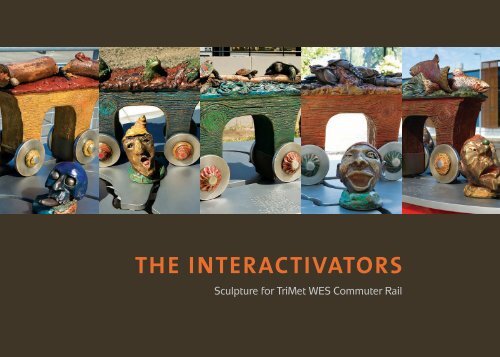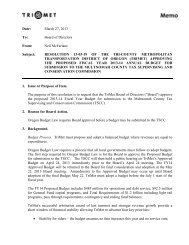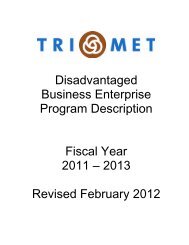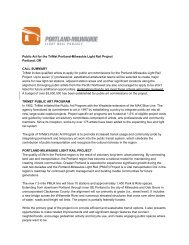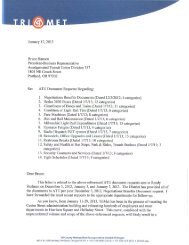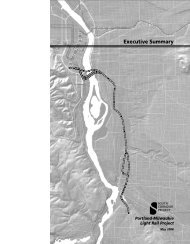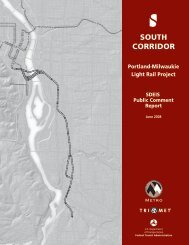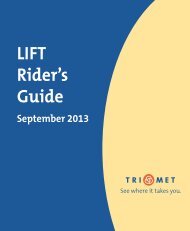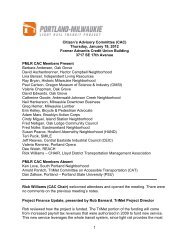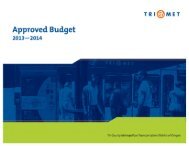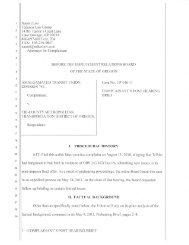The Interactivators WES Public Art Guide 7.1MB PDF - TriMet
The Interactivators WES Public Art Guide 7.1MB PDF - TriMet
The Interactivators WES Public Art Guide 7.1MB PDF - TriMet
Create successful ePaper yourself
Turn your PDF publications into a flip-book with our unique Google optimized e-Paper software.
Published by:Tri-County Metropolitan Transportation District of Oregon(<strong>TriMet</strong>)4012 SE 17th AvenuePortland, Oregon 97202503-238-RIDE (7433)trimet.orgCopyright 2009 by Tri-County Metropolitan TransportationDistrict of OregonAll rights reserved. No part of this book may bereproduced or transmitted in any form or by any means,electronic or mechanical, including photocopying,recording, or by any information storage and retrievalsystem, without written permission from the publisherexcept for the inclusion of brief quotations in a review.Library of Congress Cataloging-in-<strong>Public</strong>ation DataPriester, Mary<strong>The</strong> <strong>Interactivators</strong>: Sculpture for <strong>TriMet</strong> <strong>WES</strong> Commuter Railby Mary Priester.- 1st ed.ISBN 978-0-9666762-1-11. Tri-County Metropolitan Transportation District ofOregon-<strong>Art</strong> Collections. 2. <strong>Public</strong> art-Oregon-PortlandMetropolitan Area. 3. Railroads, Local and light-Oregon-Portland Metropolitan Area-Miscellanea.Editing: Judy BlankenshipDesign: Ian BoydenPhotography: Tim Jewett cover and pp. 25-29, other photos by Lore Fauver Rude, MurraySampson, <strong>TriMet</strong> staff.Printed by Lowell’s Print Inn, Portland, Oregon2
ContentsPreface 5Introduction 9<strong>The</strong> <strong>Interactivators</strong> 13Installation Views 24Cast of Characters 30Acknowledgements 47Contributors 483
BeavertonTransit CenterWashington SquareTransit CenterTigardTransit Center4
PrefaceOregon’s first commuter rail line, WestsideExpress Service (<strong>WES</strong>), was unveiled onJanuary 30, 2009. More than ten years in themaking, and one of <strong>TriMet</strong>’s most innovative andchallenging projects yet, <strong>WES</strong> Commuter Rail is oneof the few suburb-to-suburb commuter rail lines inthe nation, serving a 14.7-mile stretch between thecities of Beaverton, Tigard, Tualatin and Wilsonville,and connecting to MAX Light Rail in Beaverton.As early as 1996, local officials had begun exploringalternatives to improve transit options forresidents and employees in fast-growing easternWashington County. <strong>The</strong>y identified a unique opportunityin a 100-year-old rail corridor, owned byPacific & Western Railroad (P&W) and used primarilyfor freight transport. <strong>The</strong>y saw the potential touse this resource for adding a commuter rail linethat would ease congestion on the heavily traveledInterstate 5 and Highway 217 roadways.Facing page, left to right:Oregon Electric Railway, Tualatin StationMap of <strong>WES</strong> Commuter RailStaff meeting at <strong>WES</strong> Maintenance Facility, WilsonvilleAlong with county officials, the mayors of Beaverton,Tigard, Tualatin, Wilsonville and Sherwoodall championed the idea. Feasibility studies wereinitiated, and when further studies were required,5
Top row, left to right: Working on <strong>WES</strong>, cutting rail, <strong>WES</strong> staff with new DMUBottom row, left to right: DMU (Diesel Multiple Unit); Neil McFarlane, Tuck Wilson, Steve Witter; Oregon congressional delegation at Commuter Rail Groundbreaking6
Oregon House member Tom Brian tooka leadership role to secure funding. Hecontinued to lead the project as chairof the Washington County Commission.In 1999, the County, working with theFederal Transit Administration, stafffrom Metro, <strong>TriMet</strong> and the Oregon Departmentof Transportation, launchedan Alternatives Analysis to consider theviability of commuter rail, and to assessits potential impact on the environment.By 2001, planners had applied to theFederal Transit Administration (FTA) forhelp to fund the project. Unfortunately,the FTA had just changed the rules forhow they rated projects, and the <strong>WES</strong>ridership projections no longer mettheir criterion for cost-effectiveness.Local leaders persevered by teamingwith Oregon Governors John Kitzhaberand Ted Kulongoski, the Oregon Statelegislature and Oregon’s Congressionaldelegation, including Senator GordonSmith and Representative David Wu,to obtain federal funding for the <strong>WES</strong>project.Following lengthy negotiations withP&W, an agreement was reachedwhereby <strong>TriMet</strong> would get priority torun trains in the morning and afternoonpeak commuting hours. Existing trackwas replaced along the commuter railline to accommodate the new railcarspeeds of up to 60 mph, and additionaldouble track was constructed in Tigardto allow freight and commuter trainsto pass each other along the route.A state-of-the-art signal system withcomputerized dispatch was installed forvehicle coordination and safety.Colorado Railcar Manufacturingproduced the highly specialized, fuelefficient,DMU (diesel multiple unit)cars. <strong>The</strong> firm’s financial problemsresulted in costly delays, but theirself-propelled railcars were the onlyvehicles that met federal “Buy America”requirements as well as federal safetystandards necessary to operatealongside active freight trains.As with nearly all of our region’s masstransit projects—Westside MAX, AirportMAX, Interstate MAX and the futureMAX Green Line—a percentage of <strong>WES</strong>funds were set aside for art.Thanks to the skillful efforts of <strong>TriMet</strong>’spublic art manager, Mary Priester, andart coordinator, Michelle Traver; membersof the <strong>Art</strong> Advisory Committeeand the artists themselves, we are ableto offer another body of high-qualityartwork that will serve our riders andenrich our communities for many yearsto come.Neil McFarlaneExecutive Director<strong>TriMet</strong> Capital Projects7
Introduction<strong>The</strong> Washington County Commuter Rail art programofficially began in the fall of 2002 in theMastodon Room of the Tualatin City Library. At thefirst meeting of the Commuter Rail <strong>Art</strong> AdvisoryCommittee, a select group of artists and art professionalscame together representing each of thecommunities that would be affected by the newline. <strong>The</strong>y met that day with much excitement and acertain degree of urgency, as the project—they weretold—was on a very fast track. After introductorypresentations by <strong>TriMet</strong>’s public art manager, MaryPriester, and project manager, Steve Witter, committeemembers were asked to verbalize their visionfor the new art program. Despite their varied backgrounds,those present were in almost completeagreement: the art should be “cutting edge,” “pushthe envelope” and “shake up the suburbs.”In accordance with <strong>TriMet</strong>’s percent for art policy,the art budget for the five-station commuter railproject, subsequently named <strong>WES</strong> (WestsideExpress Service), was $500,000. <strong>The</strong> <strong>Art</strong> AdvisoryCommittee was responsible for overseeing thisallotment, selecting the artists, and reviewing theproposed artwork.9
That fall of 2002, when the committeefirst met, <strong>WES</strong> was expected to receiveapproval to enter the final design phasewithin weeks, and to begin constructionthe following summer. Train service wasscheduled to start in September 2005.But by spring of 2003, the FederalTransit Administration (FTA) had notyet approved the project for funding.Unaccustomed to a suburb-to-suburbproposal, the feds were uncertain thatridership numbers would warrant theirinvestment. While they reviewed theratio of cost-to-riders, the project couldnot move forward. Final design was delayeduntil after June 2003, and openingday was postponed to 2006, a fullyear later than originally planned. Otherfactors such as shifting design requirementsand slow permitting processeseventually added nearly three yearsmore to the schedule.Transporter concept modelUnaware of the delays to come, thecommittee had selected two artists,who had applied separately, to worktogether as a team to develop an artplan and design artwork for the newstations. To everyone’s chagrin, thismatch proved to be unsuccessful, andonly one of the artists, Frank Boyden,was asked to continue. Boydensubsequently proposed that he workwith the artist Brad Rude. Based onthe duo’s remarkable collaboration atDoernbecher Children’s Hospital, thecommittee approved the new team.Boyden and Rude presented theirconcept in May 2003, and the boldideas that would become the hallmarkof their final work were alreadyevident. <strong>The</strong>y knew from experiencethat for their artwork to remain vital tocommuters, who would be exposedto it daily over years, it needed to bephysically engaging. <strong>The</strong>ir goal wasto draw in train riders with art that10
would not fade into the backgroundafter several viewings, but wouldremain compelling and personallyrelevant. Rather than create numerousindependent works, Boyden andRude further proposed that the <strong>WES</strong>artwork be “a great continuous thread,”linked both visually and thematically.To their knowledge, this concept wasunprecedented in public art. <strong>The</strong>committee responded cautiously,but gave the artists the green lightto develop their idea for a single,interactive artwork.<strong>The</strong> following month, Boyden andRude arrived at the <strong>Art</strong> AdvisoryCommittee meeting with a sheaf offreely drawn sketches, evidence ofan intensely energetic and prolificcreative process. Dark lines runningon the verge of chaos suggested rollercoasters, carousels and game boards.Animal and human figures populatedthese images, which envisioned theviewer as a participant who couldmove or change the configuration ofthe artwork. <strong>The</strong> artists spoke abouthow their sculptures would mimic thechanges of life, evolving and changingon a daily basis. <strong>The</strong> committee, withsome trepidation, once again expressedtheir confidence in the duo. <strong>The</strong>y wereenthused by the notion of kineticart engaging riders, but recognizedthe maintenance and securitychallenges inherent in creating publicart with moving parts. One memberoptimistically predicted that riderswould choose to travel the entire linejust to experience the artwork.<strong>The</strong> <strong>WES</strong> project continued to encounterdifficulty winning the necessary federalfunds, and there was at least oneoccasion when the whole complicateddeal threatened to come apart. Inthe summer of 2006, administratorsinformed staff that the art program,among other important projectelements, was in danger of being cut.After a thorough and heartfelt appeal,the promise was eventually made: if theproject went forward, the art programwould stay intact.On July 21, 2006, the <strong>Art</strong> AdvisoryCommittee met to review Boyden’sand Rude’s final design. As memberssettled in with their coffee and treats,Steve Witter announced that his <strong>WES</strong>team had just submitted the completeddesign documents and contractorswere starting work that very day.<strong>The</strong> excitement around the table waspalpable as the artists brought out arough model of their design for thefirst time. A cardboard vehicle and afew sculpted heads were evidenceenough that the jumble of ideas andinspiration the committee had glimpsedthree years earlier would find theirconsummate form.11
<strong>The</strong> <strong>Interactivators</strong>Uncle Skulky has his eye on <strong>The</strong> Scowler,but doesn’t notice that he is hiding behind<strong>The</strong> Historical Head Mask, having a “cheerful”conversation with <strong>The</strong> Laugher. <strong>The</strong> Sleeper isnapping, oblivious to the joke being shared between<strong>The</strong> Goofball and <strong>The</strong> Vegetable Head. What isgoing on here!?I have spent the entire day with these characterswhile assisting the photographer, and they arebeginning to get to me. I look at <strong>The</strong> Goofball andsee my son. <strong>The</strong> Carrier of the Stone reminds me ofsome nagging tasks left undone (I should write mybrother today and send a card to my sick friend).But I’m tired! That Sleeper makes me want to gohome and take a nap!<strong>The</strong>se sculptures have magic. I have seen it fromthe moment the first of <strong>The</strong> <strong>Interactivators</strong> wasunwrapped. Like kids with a new toy, everyperson on the platform at Wilsonville Stationwas irresistibly drawn in. Construction workers,engineers and truck drivers crowded around theten-foot long stainless steel table and began toplay, moving the bronze heads and wheeled13
train car around in their tracks,spouting imaginary dialogue. Thishappened throughout the day at everystation, and continued into the next,even after the sculptures had beenprotectively covered. (Project managerSteve Witter confessed that he andanother colleague were taking a peekwhen a train engineer pulled up andsaid he wanted a look too. He hadseen the project featured on OPB <strong>Art</strong>Beat and was eager to set eyes on thefinished sculptures. )<strong>The</strong> surprising thing about all this isthat the five-part <strong>Interactivators</strong> is nottypical public art. It doesn’t tell the historyof the place or celebrate a culturalmilestone. It wasn’t vetted by the communityat large or fabricated by subcontractors.In the complexity of its content,its personal scale and the rich detail ofthe surfaces, it is more the type of workyou would see in an art gallery than ina public space. This is artwork made inthe sanctuary of the studio by artistswho not only embraced the concept ofpublic art, but also sought to elevate it.For six years, the ideas behind <strong>The</strong> <strong>Interactivators</strong>brewed in the minds of theartists, Frank Boyden and Brad Rude.Seldom is there that much time to ruminateon a public art project and longdelays are usually grounds for grumblingand complaint. Ideas presented atthe beginning of a lengthy project seldomget reworked; more often they justget stale. So I was struck by the artists’claim on several occasions that theywere actually glad for the additionaltime.For Boyden, an artist who hascontinually pushed the boundariesof his art, this span of time wasan especially fertile one. Havingestablished his reputation as oneof the finest and most innovativeceramic artists in the country, Boydenhad also completed a number ofprominent sculpture commissions andan impressive printmaking oeuvre. In2003, the year following his and Rude’sconcept presentation, Boyden createda series of prints titled <strong>The</strong> Irreverences,Provocations & Connivances of UncleSkulky. Like Goya’s Caprichos, whichchronicled the superstitions, vanityand folly of late 18th century Spanishculture, this series was dark andintrospective, a reflection of the post-9/11 era.Two years later, Boyden began a seriesof drypoint prints titled <strong>The</strong> Empathies,in which he sought again to unmask theabsurdity of the human condition. Hedescribes his efforts on this series as, “aClockwise from left:<strong>Art</strong>ists drafting table top slotsA concept drawing<strong>The</strong> Beaverton Interactivator (detail)14
journey begun in the grip of anger anddisgust and concluded in humility andcompassion.” Boyden completed <strong>The</strong>Empathies shortly before he and Rudebegan developing the cast of charactersfor <strong>The</strong> <strong>Interactivators</strong>. His deep,creative explorations over this five-yearperiod appear to have paved the wayfor Boyden to approach this new projectwith greater sympathy and humor.Before he teamed up with Boydenon the commuter rail project, sculptorBrad Rude’s work typically featuredanimals, often grouped together andpaired with emblematic objects such asrocks, scales and wheels. He sculptedhis creatures—from dogs and goats tobears and rhinos—with a mix of realismand fantasy to create symbols of thehuman condition. Bringing his skills inmodeling, bronze casting and patina,Rude jumped into the project withBoyden, boldly taking on the humanfigure for the first time.<strong>The</strong> <strong>Interactivators</strong> represents aculmination of sorts in Boyden’s andRude’s art. It brings together theirdesire to see clearly who we are andto mirror that reality with honesty andcompassion. While the primary meansis the archetypal heads, every elementof <strong>The</strong> <strong>Interactivators</strong> contributesto this end. <strong>The</strong> table shape, whichevolved from earlier loops and swirls,was selected for its simplicity andstability. Comfortably approachable,it also clearly defines the area of play.Slots cut into the tables allow for themovement of the heads and vehicles.<strong>The</strong> entire work is like a microcosm ofthe station itself—the table is analogousto the platform, the vehicle is thetrain, and the slots are like the myriadpathways people travel to arrive there.<strong>The</strong> artists write in their proposal aboutRude sculpting a Headwith Animal Qualities17
the “existential problem” that travelersfind themselves in, thrown togetherby chance and having no choice but tointeract in some way or another. <strong>The</strong><strong>Interactivators</strong> offer the riders of <strong>WES</strong>a surrogate world, a playground wherethey are invited to interact with “sculpturalcounterparts” without “the culturaltaboos they might feel in the confinesof a train station or a train car.”To specify their intentions, the artistsengraved instructions on each of thefive tables:This sculpture, a theater of sorts,explores human interactions foundin places where people come together,such as this train line. <strong>The</strong>cast of characters expresses varioustraits, gestures, states of mind,emotions, feelings and fantasies.You decide who goes where andwhat path they will take. By activating,you will create new scenariosbetween the characters. Use yourimagination, trust your instincts andhave fun.While the game is designed to beplayed by one person—or an entirestation full of riders—it reaches itsfullest potential when more thanone person plays at a time. <strong>The</strong>n, thesculptures provide an opportunity totransform isolation and awkwardnessinto social connection. <strong>The</strong>re are nowinners or losers. Players initiateencounters and invent narratives, evenshort plays, and in the process createconnections that ultimately strengthenthe fabric of our communities.Like a permanent theater program, theCast of Characters is engraved on eachtable right below the instructions:<strong>The</strong> Kisser, <strong>The</strong> Blind Head, <strong>The</strong>Mirror of Illusion, <strong>The</strong> Sleeper, <strong>The</strong>Double Head, <strong>The</strong> Found ObjectHead, <strong>The</strong> Laugher, <strong>The</strong> FacelessMask, <strong>The</strong> Carrier of the Stone,<strong>The</strong> Scowler, <strong>The</strong> Vegetable Head,<strong>The</strong> Historical Head Mask, <strong>The</strong>Goofball, <strong>The</strong> Upside Down Head,<strong>The</strong> Head with Animal Qualities,Uncle SkulkyBoyden and Rude developed the castto represent a universally relevant,cross-section of humanity. <strong>The</strong>y onlyhad a limited number of roles available,however, and it is telling to examine thechoices they made. Although severaltraditional archetypes are obvious—<strong>The</strong>Kisser is the Lover, <strong>The</strong> Goofball theFool and Uncle Skulky, though vergingon parody, is clearly Death—most ofthe classic characters of fairy talesand fortunetelling are not present.In place of the King and Queen, theWitch and the Fairy Godmother, thereis <strong>The</strong> Upside Down Head, <strong>The</strong> BlindHead, and <strong>The</strong> Carrier of the Stone. Insome, we can easily identify our own18
<strong>Art</strong>ists applying paint and patina to one of the Vegetable Heads19
emotions (<strong>The</strong> Laugher is “happy,” <strong>The</strong>Scowler, “angry”), but Boyden andRude want to hold up a mirror to themore subtle qualities of our condition:befuddlement, anxiety, ennui andambivalence, among others.<strong>The</strong> artists strove to imbue thecharacters with the greatest potentialfor interactions and imaginativenarratives. <strong>The</strong>y achieved this in partby representing specific characteristicssuch as gender, age and ethnicity with adegree of ambiguity. <strong>The</strong>y offered evenmore opportunities for empathy (orantipathy!) between rider and characterby sculpting one-of-a-kind variationsfor fifteen of the sixteen character typeson each table. <strong>The</strong> only character thatdoes not appear in a different guiseis <strong>The</strong> Blind Head. One of the morepsychologically complex of the heads,it made sense to the artists to simplyreplicate for each table this blindfoldedfigure whose back half consists of apolished mirror surface.From the beginning, Boyden and Rudewanted to include direct references tothe world of art and to the principalethnic groups of the region in the castof characters (African American, NativeAmerican, Hispanic, European, andAsian). But would every rider “get”the art world reference, and wouldthe ethnic heads result in a divisivestereotyping? <strong>The</strong> artists’ ingenioussolution was <strong>The</strong> Historical Head Mask.By expressing individual cultures with amask, a significant art form is invokedand no one is excluded; anyone can“wear” the mask and thereby share inthat particular culture.While Boyden and Rude expect thatthe players will gain some insight aboutthemselves and others, they also hopetheir participation will produce “a lotof pleasure and laughter and generallya good time.” To this end, humor isliberally sprinkled on every sculpturetable. You can almost hear the artistschuckling to themselves as theypainted the painted turtles, devisedhow to make Uncle Skulky’s tonguemoveable, or added the crab claw to<strong>The</strong> Goofball’s nose!<strong>The</strong> bronze vehicle, named <strong>The</strong>Transporter for its ability to movethe character heads from place toplace, has a critical role to play in <strong>The</strong><strong>Interactivators</strong>. Like some primitivetrain car, <strong>The</strong> Transporter carries theimprint of rough wood on its sides andhas loosely fitting wheels that causea clankety-clank sound when rolledacross the slotted table. Players canintegrate <strong>The</strong> Transporter into theirnarrative by using it to move theircharacters, or they can simply roll italong the track by itself.<strong>The</strong> Transporter also reflects the20
individual identity of the five stationareas. When the artists solicited ideasfrom the committee members on howbest to represent their community,they noticed that among the many cityicons and landmarks there is one thatweaves throughout the corridor. Allthe station areas share a geographydominated by water: either the TualatinRiver Watershed or the WillametteRiver. <strong>The</strong> train route actually traversesnative wetlands and offers viewsof nature otherwise inaccessible.Beaverton and Tualatin already hadaffiliations with wetland animals (anamesake beaver and annual crawfishcelebration), and it was easy to extendthe motif to the remaining cities ofTigard and Wilsonville. In addition tothe identifying animal, the body of eachMary Priester with artistsat Walla Walla Foundry21
transporter is painted a unique colorthat matches the bright stripe belowthe tables’ surface.<strong>The</strong> animals that distinguish theindividual transporters are renderedmore or less realistically in their habitat,and make a handsome juxtapositionwith the cacophony of characterheads spread around them. <strong>The</strong>re issome intentional irony here, as thoseanimals—endangered by the spreadof the cities—ride high on the vehicles,lords of the land once again!Boyden and Rude employed anexpansive formal repertoire to rendertheir multitude of characters andanimals. From the classical eleganceof <strong>The</strong> Blind Head to the expressivegesture of <strong>The</strong> Scowler, the naturalismof the animals, and the funky humorof <strong>The</strong> Found Object Head, the style ofthe sculpture is tailored to the natureof the character represented. At thesame time, all of these sculptures areunabashedly hand-made; thumbprintsabound amid swells and dapples ofpushed clay, and even the carefullysmoothed surfaces are evidence of theartists’ expert touch.<strong>The</strong> transparency of the art-makingprocess indirectly supports the radicalidea at the heart of these sculptures—the opportunity for the viewer toengage in the making and continualremaking of the artwork. As Boydenand Rude wrote, “the participants aremaking a piece of art that physicallyand mentally works for them.” <strong>The</strong>artists have provided the elements andset the parameters of the work, but theviewer/participant is the one invitedto compose it. In this way, he or shebecomes a co-creator of the sculptureand continues the collaboration thatBoyden and Rude began together.Psychologically astute, sociallyprogressive and artistically original, <strong>The</strong><strong>Interactivators</strong> is a masterwork in theoeuvre of two of the northwest’s mosttalented sculptors. It is also a fittingcounterpart to the innovative <strong>WES</strong>Commuter Rail and a brilliant additionto the public art collections of both<strong>TriMet</strong> and the region.As I start to walk away at the end ofthat long first day, I catch a glimpse ofsomething like a spark out of the cornerof my eye. Was someone on the tablewinking at me? I approach <strong>The</strong> BlindHead, give it half a turn and then I seeit, my own bright reflection. I leave,feeling a bit tender-hearted, knowingI’ll be back—for one thing, <strong>The</strong> UpsideDown Head seems to be trying to tellme something...Facing page:<strong>The</strong> Beaverton Interactivator,32”x 120” x 32”, at Walla Walla Foundry22
<strong>Art</strong>ists’ instructions engraved on each Interactivator:Installation viewsThis sculpture, a theater of sorts, explores humaninteractions found in places where people cometogether, such as this train line. <strong>The</strong> cast of charactersexpresses various traits, gestures, states of mind,emotions, feelings and fantasies. You decide who goeswhere and what path they will take. By activating, youwill create new scenarios between the characters. Useyour imagination, trust your instincts and have fun.24
<strong>The</strong> BeavertonInteractivator25
26Th e Hall /n imbusInteractivator
Th e tigardInteractivator27
28Th e tualati nInteractivator
Th e wi lsonvi lleInteractivator29
Cast of Characterswith artists’ descriptions<strong>The</strong> Kisser<strong>The</strong> Blind HEAD<strong>The</strong> Mirror of Illusion<strong>The</strong> Sleeper<strong>The</strong> Double Head<strong>The</strong> Found Object Head<strong>The</strong> Laugher<strong>The</strong> Faceless Mask<strong>The</strong> Carrier of the Stone<strong>The</strong> Scowler<strong>The</strong> Vegetable Head<strong>The</strong> Historical Head Mask<strong>The</strong> Goofball<strong>The</strong> Upside Down Head<strong>The</strong> Head with Animal QualitiesUncle Skulky30
<strong>The</strong> Kisser<strong>The</strong> Kisser represents the need to give and receive affection. Thischaracter is important as one who has the potential to makeobvious connections of love and good will.31
<strong>The</strong> Sleeper<strong>The</strong> Sleeper is symbolic of the person in every group who is “out ofit” or maybe actually asleep. We’ve all been there.32
<strong>The</strong> Laugher<strong>The</strong> Laugher simply represents a very happy or joyous person.33
<strong>The</strong> Scowler<strong>The</strong> Scowler is the opposite of <strong>The</strong> Laugher, representingfrustration, anger and generally a bad, menacing attitude.34
<strong>The</strong> Goofball<strong>The</strong> Goofball is a catawampus, crazy looking, clumsy, delightfullyabsurd and harmless person.35
<strong>The</strong> Blind Head<strong>The</strong> Blind Head is symbolic of the moments in life that we cannot–or refuse to–see. <strong>The</strong> back of the head is a mirror that allowsplayers to look at themselves and consider this concept. Thischaracter appears the same on each table.36
<strong>The</strong> Double Head<strong>The</strong> Double Head is symbolic of duality or our states of confusion.This character has a face on the front and the back, sort of a “pushme-pull-you”concept.37
<strong>The</strong> Faceless Mask<strong>The</strong> Faceless Mask represents anonymity, the desire to hideor not participate, or maybe those who cannot or will notexpress themselves.38
<strong>The</strong> Vegetable Head<strong>The</strong> Vegetable Head is basically just an absurdity, a way of pokingfun at humanity.39
<strong>The</strong> Upside Down Head<strong>The</strong> Upside Down Head is associated with confusion, feeling topsyturvy,being in love, or a realization that one is in the wrong placeor the wrong state of mind. It can also have associations withabsurdity and clowning around.40
Uncle SkulkyUncle Skulky is an essential element in the game, as death is areality that is always there. This character is fitted with humorousdevices to break its usual heavy connotations, for instance eyeballsand tongues that can be moved by the players.41
<strong>The</strong> Mirror of Illusion<strong>The</strong> Mirror of Illusion is a double-sided, stainless steel mirror.People look in mirrors to see who they really are, but they can neverquite get the right information. Little creatures at the bottom of themirror make fun of whoever is looking in.42
<strong>The</strong> Found Object Head<strong>The</strong>re are many everyday objects loaded with meaning that candouble as heads. <strong>The</strong> Found Object Head helps participants relatethemselves to the world outside specific human relationships.43
<strong>The</strong> Carrier of the Stone<strong>The</strong> Carrier of the Stone is symbolic of whatever each of uspacks around. It can be seen as something positive, like wisdom,or as a burden.44
<strong>The</strong> Historical Head Mask<strong>The</strong> Historical Head Mask represents different ethnic groups. Everyculture uses masks, and these pieces represent the importantcontribution each group makes to the world we live in.45
<strong>The</strong> Head with Animal QualitiesAs humans we easily identify with other animals. <strong>The</strong>se piecespresent serious, comical or metaphysical references to animals wefeel close to or have associations with.46
Acknowledgements<strong>The</strong> <strong>WES</strong> Commuter Rail <strong>Art</strong> Program wasexceptionally challenging with many dramaticups and downs. For this reason I am so very gratefulto every one of the Commuter Rail <strong>Art</strong> AdvisoryCommittee members who stuck with us through it alland for such an inordinately long time! <strong>The</strong>ir willingnessto go out on a limb in support of “cutting edge” art andto give the artists the benefit of the doubt when theyneeded it was what ultimately assured the success ofthis program. I want also to thank my colleagues JoeWalsh, who supported the art program at the earliestfunding stage; Steve Witter, a stout ally throughout theyears; and Michelle Traver who bravely stepped in forme when I was down in a battle of my own. KatrinaSarson and her <strong>Art</strong> Beat crew gave us all a welcomeboost by highlighting our efforts on “Everybody’s <strong>Art</strong>”(www.opb.org). Finally, I am grateful to Frank Boydenand Brad Rude, two artists whose talent and dedicationare equaled only by their warm hearts and generousspirits. I feel immensely proud to have been part of theteam that helped them bring <strong>The</strong> <strong>Interactivators</strong> intobeing.Mary Priester<strong>TriMet</strong> <strong>Public</strong> <strong>Art</strong> Manager47
Contributors<strong>Art</strong>istsFrank BoydenBrad RudeCommuter Rail <strong>Art</strong> Advisory CommitteeAnne AveryJoan ChapinSoo Kim GordonChris LewisPaul MissalLoren NelsonSteve WitterDiane GoodwinDebbie HuntingtonKen KirseMonika LackeyNeil McFarlaneChris NovotnyTony RobertsPaige SchluppDave TertadianJoe WalshTuck WilsonSteve WitterSpecial ThanksRick BartowJane BoydenLillian PittLore Fauver RudeOregon <strong>Public</strong> BroadcastingGreg BondJessica MartinKatrina SarsonTom ShriderBill Ward<strong>Public</strong> <strong>Art</strong> StaffMary PriesterMichelle Traver<strong>TriMet</strong> StaffAnn BecklundSandy BradleyJeb DoranLance ErzJohn FallSubcontractorsWalla Walla Foundry, Walla Walla, WAHardrock Machine Works, Walla Walla, WADavid’s Aquacut and Builders, College Place, WACrown Plating, Vancouver, WAStacy and Witbeck, Inc.Brent AllisonJustin PoelingGeran Shankar48


